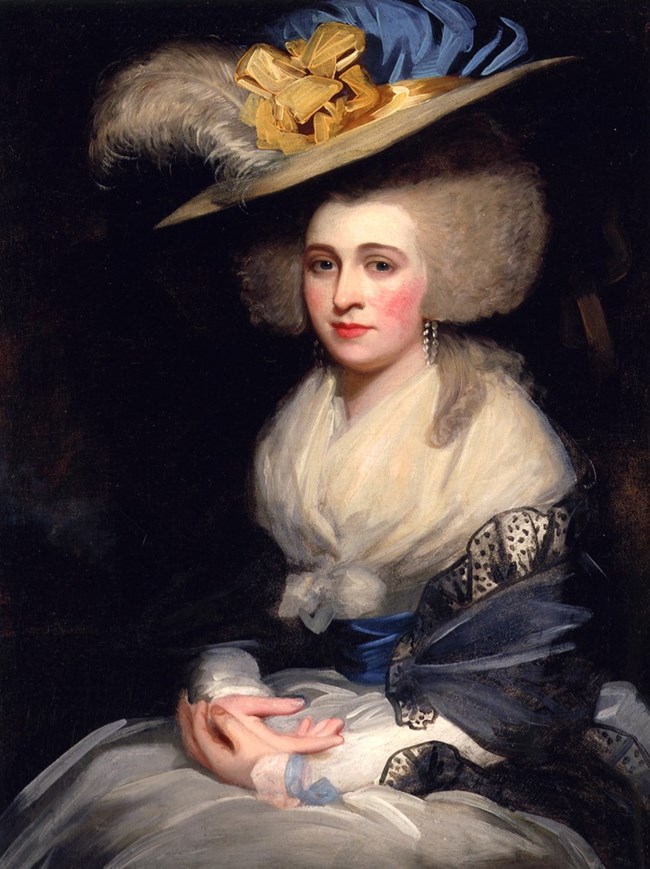
NPS Abigail Amelia “Nabby” Adams Smith - oldest child and only surviving daughter of John and Abigail Adams - was a witness to the American Revolution, a transatlantic traveler, and a loving family member. Nabby was born and raised in the saltbox house now known as the John Quincy Adams birthplace. Born July 14, 1765, she was the oldest child of John and Abigail Adams. Growing up, Nabby enjoyed the privileges of an upper-middle class childhood in the colonial New England countryside. During their childhood, Nabby and her siblings were supported by John Adams’s successful career as a lawyer, lived on a prosperous farm, and were cared for by several servants. One of the servants who helped care for the children was Phoebe, a free African-American woman. Before gaining her freedom, Phoebe had previously been enslaved by Abigail Adams’s parents, and had been a caretaker to Abigail in her childhood. The American Revolution brought about drastic changes for Nabby and the rest of the family. As many early battles of the Revolution took place nearby, the family quartered soldiers in their house and melted down metal dishes for bullets. John and John Quincy Adams left for Europe in 1778, leaving Abigail and Nabby an increased role of responsibility and vulnerability. During these tumultuous years, Nabby received many letters from John Adams on his trips to Philadelphia and Europe, expressing his love and hopes for his daughter. In one letter, John wrote to her his now-famous phrase: “to be good, and do good, is all we have to do.” During the five years of her father and brother’s absence, Nabby fell in love with a young man named Royall Tyler, whom she hoped to marry. John Adams was critical of the relationship because he thought Nabby was too young. He wrote to Abigail to put their romance on hold and have Abigail take Nabby to France to get her mind off the romance. Though John Adams eventually assented to their relationship, the letter of his approval arrived after Nabby had already sailed. Royall Tyler and Nabby never met again. Tyler went on to become the first playwright in America, publishing The Contrast, the plot of which is almost identical to the events of Tyler’s courtship with young Nabby Adams. After John Adams signed the Treaty of Paris which ended the American Revolution, he was appointed minister (ambassador) to England. Nabby Adams and her mother made the month-long ocean crossing to reunite with John and John Quincy Adams in Europe. It was unusual for women to travel without the company of men, but Nabby and Abigail were used to facing challenges. They traveled throughout England, France, and the Netherlands, Nabby’s diaries reveal an observant and curious young woman who enjoyed the lively social whirl of Paris and London during the Enlightenment. Nabby became friends with figures such as Benjamin Franklin, Maria Cosway, and Martha Jefferson Randolph While living in London, Nabby fell in love with and married William Stephens Smith, former aide-de-camp to George Washington and future New York representative. She delivered her first child, William Steuben Smith, in London a year later. Contrary to many media depictions, John and Abigail did approve of the marriage. Nabby and William had a difficult marriage, personally and financially. They lived primarily in central New York and had a total of four children: William Steuben Smith, John Adams Smith, Thomas Hollis Smith, and Caroline Amelia Smith (later DeWindt). In 1809 Nabby discovered a lump in her breast. Although many aspects of medicine were less advanced than today, breast cancer was known as a dread disease. The cancer grew and, in 1811, Nabby’s parents urged her to come to Boston for treatment. Her doctor, Benjamin Rush, recommended a mastectomy. Nabby was willing to go through with the procedure, but faced a barrier: women at the time required their husband’s permission for surgery, and her husband was in denial about her illness. However she eventually convinced him the surgery was needed and he approved her to go ahead with it. On October 8, 1811, Nabby underwent a mastectomy to treat her breast cancer. The surgeon was John Warren, the top surgeon in Boston at the time. John Warren was the brother of the late Joseph Warren, a prominent doctor and friend of the Adamses who had inoculated Nabby for smallpox as a child. In the age before anesthesia or many modern surgical equipment, the surgery was a grueling and painful undertaking. Nabby survived her surgery and initially believed her cancer was cured. However, she continued to experience headaches and abdominal pain. Soon, it was clear to her and her doctors that her cancer had metastasized. In May of 1813, Nabby told her husband that she “wanted to die in her father’s house.” William Smith made the arrangements for her to travel back to Massachusetts once more. Nabby died at Peace field on August 15, 1813, two years after her surgery. A few days after Nabby’s death, John Adams wrote to family friend Thomas Jefferson: "Your Friend, my only Daughter, expired, Yesterday Morning in the Arms of Her Husband her Son, her Daughter, her Father and Mother, her Husband's two Sisters and two of her Nieces, in the 49th Year of Age, 46 of which She was the healthiest and firmest of Us all: Since which, She has been a monument to Suffering and to Patience." Nabby is buried in Hancock Cemetery, near many other family members. |
Last updated: October 12, 2022
